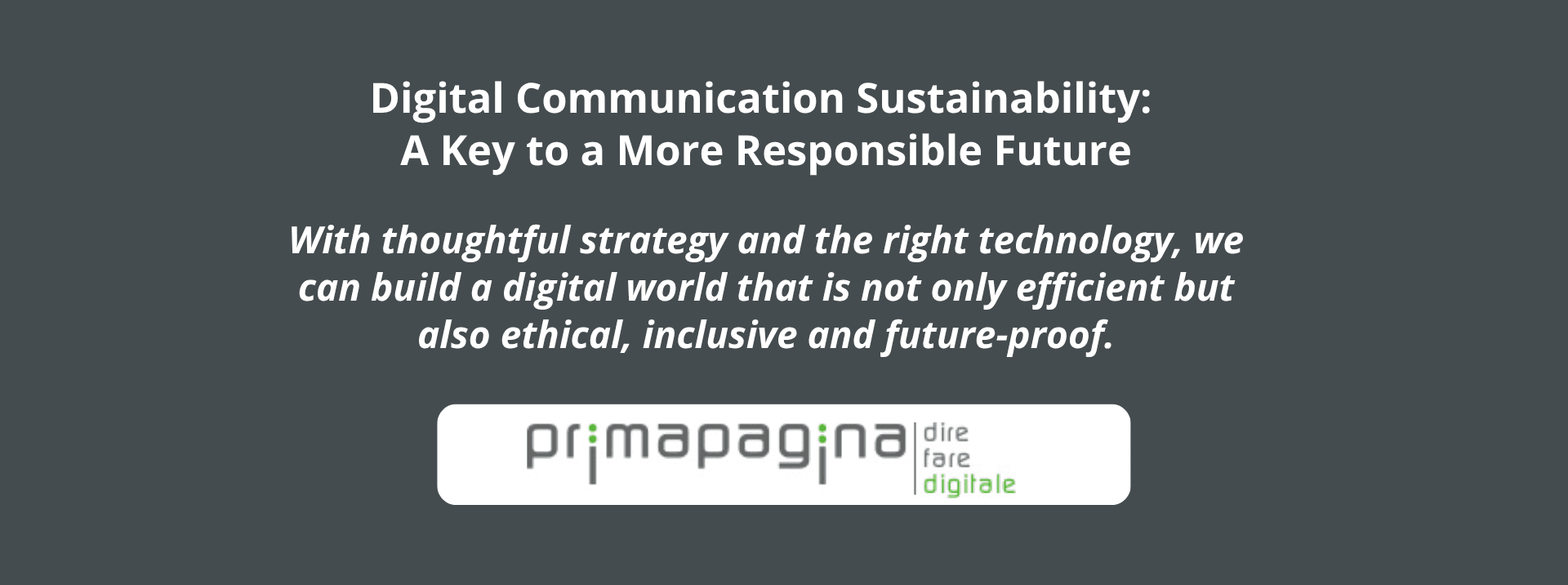In a world where digital transformation is reshaping languages, toolsand relationships, questioning the impact of our communication practices is not optional: it’s a necessity. As communication professionals, we have the responsibility to consider the sustainability of our digital activities. And while the concept of Digital Communication Sustainability is still emerging, it has already begun to make its way into the agendas of forward-thinking organizations.
Digital communication sustainability means adopting practices and technologies that minimize the environmental, social, and economic footprint of our digital ecosystem—both in terms of infrastructure and inclusive content. But to truly make an impact, we need more than good intentions: we need a clear and shared model.
A sustainable model for Digital Communication
The impact of digital transformation touches every aspect of our lives and today, more than ever, there’s an urgent need for common principles to guide communication professionals toward more responsible choices. We must integrate sustainability into communication strategies with a holistic view that considers technological, ethical, social, and environmental dimensions.
Digital is not just a driver of innovation: it’s a lever for building a more inclusive and fair future. Communication activities must be reimagined as an act of responsibility, as an architecture of words and technologies that breaks down barriers, protects the planet and amplifies diverse voices.
In our hyper-connected world, digital sustainability is no longer a nice-to-have. It’s a must, if we want to ensure fairness and responsible use of resources.
A new vision for communication
What’s needed is a concrete, responsible vision for the evolution of communication—one that integrates online and offline channels into a systemic and sustainable perspective. Sustainability, in this context, is both a methodology and a goal. Communication must not only respect the environment, it must also become a vehicle for promoting cultural models and behaviors focused on collective well-being.
We live in a digital ecosystem that influences opinions, shapes decisions, and defines the context in which we live. This reality places immense responsibility on communication professionals. We can no longer evaluate communication efforts only after they happen—looking at metrics like clicks and impressions. We must also consider their environmental and social impact. Communication must be conscious. It must build bridges.
Collaboration is essential
Achieving truly sustainable digital communication requires collaboration. Companies, media outlets, digital platforms, institutions, and professionals must work together to build more inclusive, equitable, and sustainable communication models.
Ongoing education and training are essential. Digital sustainability is not a fixed destination—it’s a continuously evolving process that demands awareness and commitment. This means fostering not only technical skills, but also a broader cultural understanding—one that must also reach the public sector and civic life.
Key players already active in this space are showing that progress is possible—especially when collaboration is combined with transparency, innovation, and a shared sense of responsibility.
Practical steps for Sustainable Digital Communication
Sustainable digital communication also requires concrete action. On top of paying attention to the language we use, there are some key areas to focus on:
- Environmental Impact
The production and use of devices and digital infrastructure (data centers, servers, cables) consume large amounts of energy and generate CO₂ emissions. - Digital Content
Heavy digital assets—like unoptimized images or high-resolution videos—increase energy consumption and bandwidth usage, worsening the digital carbon footprint. - Mindful Technology Use
We must encourage intentional and responsible use of technology, avoiding information overload and limiting unnecessary screen time. - Accessibility and Inclusion
Digital content must be accessible to everyone, regardless of physical or cognitive ability, and reflect cultural and social diversity. - Transparency and Accountability
Honest, ethical communication is crucial. That includes responsible data handling and delivering clear, truthful information. - Awareness and Education
Raising awareness—among professionals and the public—about the environmental and social impact of digital communication is essential for long-term change.
What we can do today
- Optimize websites
Compress images, streamline code, and choose eco-friendly hosting services powered by renewable energy. - Create lighter content
Use lower-resolution media when appropriate, reduce unnecessary visual elements, and ensure content is easy to read. - Choose sustainable platforms and providers
Partner with tech companies and platforms that have made commitments to environmental and ethical sustainability. - Select suppliers that care about sustainable communication practices
- When selecting an external partner, an editor, an agency, or a content creator ask them about their sustainability strategy
Digital Communication Sustainability encompasses values like transparency, environmental responsibility, reduced infrastructure impact, inclusion, accessibility, and the empowerment of individuals. It also emphasizes the importance of joint efforts, across companies, institutions, and platforms, and the need to prioritize continuous training, both for professionals and for users.
Digital communication must be more than just a channel: it can and should be a tool for sustainability. With thoughtful strategy and the right technology, we can build a digital world that is not only efficient but also ethical, inclusive and future-proof.
